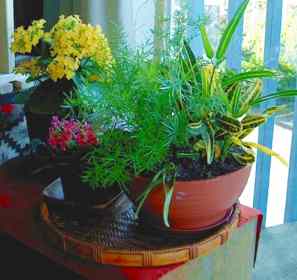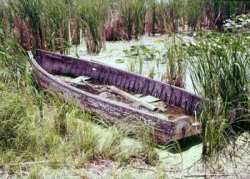 |
 |
| Home | Welcome | What's New | Site Map | Glossary | Weather Doctor Amazon Store | Book Store | Accolades | Email Us |
 | |||||||||||||||
Weather Almanac for May 2002DOGWOOD WINTERThe rather odd start to Spring 2002 across much of North America -- made more unusual by the abnormal winter just closing -- has had a strange effect on me. More so than in recent years, I have been bitten by the gardening bug, and since I have no land available to cultivate, I have turned to indoor gardening. A big advantage to indoor gardening is that I can purchase plants in many stages of growth. This gives me an instant garden, replete with flowers rather than a sparse or bare patch of land requiring patience and a faith in nature's bounty.  Indoor gardening eliminates the need to ponder the question on the minds of all non-tropical outdoor gardeners: When is it safe to plant outdoors? Here on southern Vancouver Island that can mean very early March when the cherry blossoms are bursting forth and the flowering bulbs begin to bloom. Further east, however, the days to consider outdoor planting moves into late May -- often around Victoria Day in Canada and Memorial Day in the US. This holds particularly well for the Midwest, Great Lakes/St Lawrence Valley, New England and the Maritimes. These holidays roughly correspond to dates when the likelihood of a killing frost becomes low enough to take the risk.
Dogwood Winter usually occurs after a mid-Spring warm spell and brings several days of cold, cloudy disagreeable weather, often accompanied by frost. It is believed to arrive during May and coincide with the blooming of the dogwood tree, or the blackberry bushes. According to one avid gardener, the time to plant sensitive species such as tomatoes comes in the warm weather following Dogwood Winter. I only came to know much about Dogwood Winter recently. Perhaps it is the lesser known cousin of Indian Summer and January Thaw because it is a regression to more unpleasant conditions. We anticipate Indian Summer with hope, but we dread the appearance of Dogwood Winter weather.
The dogwood is revered in North America for more than the mythology. Its beauty and utility have long been celebrated. The flowering dogwood has been adopted by North Carolina as its state flower, Missouri as its state tree, Virginia its state tree and flower. New Jersey has designated the dogwood as its "state memorial tree." British Columbia has named the Pacific dogwood blossom as its official flower, depicted a cluster of them on the provincial coat of arms. Native Americans used the dogwood for making arrows, thus giving the tree its alternate monikers "arrow wood" and "Indian arrow wood". They watched for its blossoms as signs to begin planting crops. Early colonists reportedly used every part of the dogwood except "the rustle of its leaves."
As its new leaves unfold in Spring, the dogwood tree blossoms into petal-like bracts of pure white or pink surrounding a cluster of tiny yellowish flowers. The tree remains in bloom for several weeks. In the fall the upper leaf blades turn scarlet or orange, and bright red fruits grow on the tree. The Pacific dogwood (Cornus nuttallii) is a larger tree native to the Pacific Coast from southern British Columbia to California, preferring to grow in moist, well-drained soils at low elevations often near streams. It is very shade tolerant and can prosper in the subdued light of giant conifer forests--a habitat where relatively few hardwoods can prosper.
This species can be as tall as 15 metres (49 ft) with a dense, conical or rounded crown of generally horizontal branches. In Spring (from April to June) and sometimes again in September, it blooms with enormous white blossoms. Each flower is actuality four to six leaves spaced around 30 to 40 small green flowers compacted into a central button. The Pacific dogwood has smooth brown to grey bark, appearing as rectangular scales and blocks with age. Clusters of tightly-grouped red berries develop by the end of August adding Autumn colour to the tree, along with its reddish leaves.
Written by
|
|||||||||||||||
 |
To Purchase Notecard, |
Now Available! Order Today! | |
 |
 |
NEW! Now |
The BC Weather Book: |


